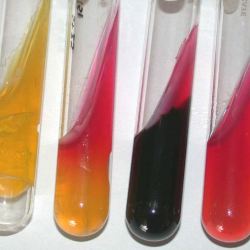In the United States, we are largely sheltered from some diseases which have a great disease burden globally. Tuberculosis (TB) is one such disease, accounting for nine million newly diagnosed cases and two million deaths annually. TB is second to Human Immunodeficiency Virus (HIV) as the top causes of death from an infectious disease according to the World Health Organization (WHO) and it is not uncommon for people with HIV to be co-infected with TB.
Even in this day and age, there is still a problem with delays in obtaining a timely clinical diagnosis. With a disease like TB, time is of the essence. Although diagnostic tests exist for tuberculosis in a clinical setting, most of these have a large margin of error or take a long time to provide results.
The Mantoux test, or the purified protein derivative (PPD) is the oldest diagnostic test that screens for TB and has been around since 1910. Once injected into the skin, usually in the forearm, an area of induration (swelling and redness) develops which indicates some type of exposure – not necessarily an active infection. Based on size of induration that develops and immune status of the patient the test is read as either positive or negative. A negative test does not rule out TB in a patient with HIV/AIDS as their immune systems are not capable of mounting an immune response. The turn-around time is 48-72 hours. The specificity of the test is 95% - meaning a positive test is pretty accurate. However, the sensitivity of this test is about 60% - which means a negative test may require further workup.
The next option is the Quantiferon gold test requires blood samples to processed by an outside lab. It is more reliable than the PPD test and more expensive. The turn-around time is about 24 hours. This test also cannot distinguish between active versus latent TB infection. This test is also not available in all labs therefore, not all facilities offer it.
In a hospital setting, patients suspected of having TB are isolated from other patients and required to provide three sputum samples, preferably the first one being an early morning sample and the other two within eight hours. If anyone has any experience with city hospitals, this translates into a lot of time. The additional time increases healthcare costs significantly, not to mention the patient is stuck in an isolation room and cannot leave. This test, like the PPD, has a high specificity of 97.5%, but the sensitivity of only 67.5%. The point of this is that diagnostic accuracy is a time sensitive matter. It seems archaic to offer a test developed in 1910 with a wide margin of error. The same is true for sputum samples.
As a clinician, I would prefer to treat if my index of suspicion is high, however, convincing the patient to take nine months worth of medications would probably be a challenge. Individuals who are exposed to TB do not necessarily succumb to the illness. In those whom the disease becomes "active" - meaning the body's natural defenses have been breached have symptoms. While the lungs are the most common site of infection, TB can affect any part of the body, such as the eyes, bones, brain, kidneys and lymph nodes. Classic signs of pulmonary TB are:
- Cough
- Weight loss/anorexia
- Fever Night sweats
- Hemoptysis
- Chest pain (can be due to TB infection of the sac surrounding the heart)
- Fatigue
Infectious droplets from these individuals who cough, sneeze, shout or sing become airborne. Transmission occurs when a person inhales airborne droplets that contain TB. When encountered in a clinical setting, time is of the essence. Early diagnosis and adequate treatment of infectious patients with pulmonary TB are necessary to reduce transmission. Some individuals, exposed to TB, do not have active disease and cannot spread it to others but are at a high risk to develop an active infection. The early identification and treatment of these patients, with Latent TB Infection (LTBI), is crucial for disease control.
Unlike elsewhere in the world where TB can be endemic, in the US it lower incidence requires a physician to have a high degree of clinical suspicion. One cannot rely solely on a single test but needs to consider a more inclusive overall clinical picture consisting of the patient's history, blood test, sputum tests, and appropriate imaging such as a chest xray or chest computed tomography (CT).
A more recent diagnostic test is the Nucleic Acid Amplification (NAA) which has its greatest benefit when clinical diagnosis is unclear. Compared with AFB smear microscopy, the added value of NAA testing is twofold. First, it has greater positive predictive value ( >95%) compared with AFB smear-positive specimens in settings in which non-tuberculous strains of mycobacteria are common. Second, NAA can rapidly confirm the presence of M. tuberculosis in 50%-80% of AFB smear-negative, culture-positive specimens. Compared with culture, NAA tests can detect the presence of M. tuberculosis bacteria in a specimen weeks before culture for 80%-90% of patients suspected to have pulmonary TB whose TB is ultimately confirmed by culture. This test is not recommended for use when the prevalence of disease is low (as it is in the U.S.) and cannot replace conventional tests just yet.
A Line Probe Assay (LPA) tests for genetic resistance to medications used to treat TB. Then there is The Xpert MTB/RIF assay, a novel, rapid and automated form of NAA testing that can detect TB along with rifampicin resistance directly from sputum within two hours of collection. It is extremely accurate, and this test may be valuable as an add-on test following smear microscopy in patients previously found to be smear-negative.
Not all these newer tests are commercially available and they may not be very valuable in areas where TB incidence is low. There is a great need to develop an assay that can rule in and rule out TB accurately and quickly while being cost-efficient. This is a disease where ease of transmission lends to its success as an agent of infection. Delays in diagnosis result in significant risks of exposure and developing new tests will result in less cost of the healthcare system and more importantly, fewer patients needing care.


